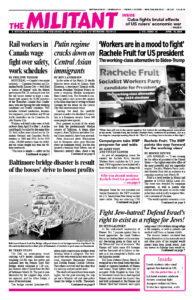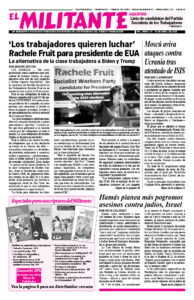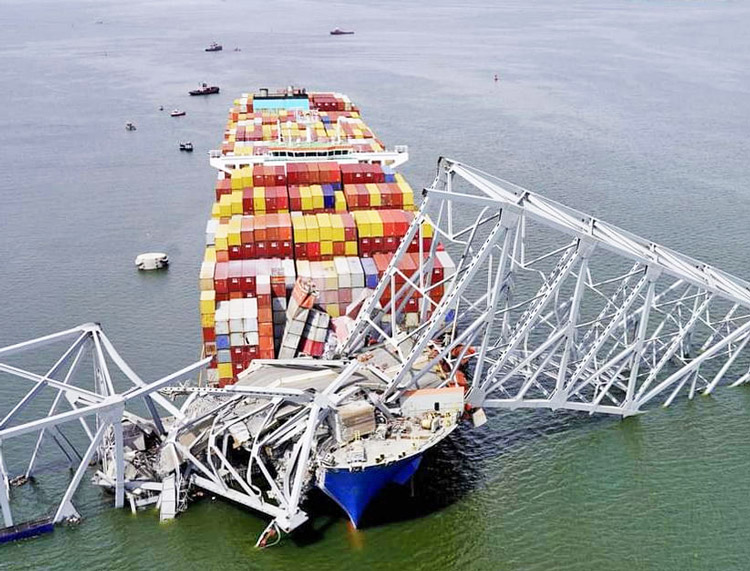The Dali, an ocean-going vessel carrying 4,679 loaded containers and weighing 123,881 tons, lost power and slammed into the Francis Scott Key Bridge, which collapsed at 1:29 a.m., just minutes after it sailed from the Port of Baltimore March 26. The port is now blockaded by the crippled ship, which ran aground, and the fallen bridge, a mass of twisted metal.
The bridge carried Interstate-695, where eight construction workers were laboring when it collapsed. The bodies of two who were killed were recovered, Alejandro Hernandez Fuentes and Dorlian Ronial Castillo Cabrera. Two others survived and the other four are missing and presumed dead.
The death toll would have been much higher, but the pilot directing the ship got out a Mayday call and state police closed the bridge to traffic. Thousands of dockworkers, ship crew members, truckers, warehouse workers and many others face an unknown future. Some 30,000 vehicles traveled over the bridge every day. City residents and travelers through the area face widespread congestion and delays.
This social catastrophe is a result of the profit-driven capitalist system.
The bridge was built in 1977, with a design known as “fracture critical,” which means if any one section breaks the whole bridge can collapse. There are no built-in redundancies. Since then shipping bosses’ drive for profits has led them to steadily increase the size, weight and capacity of container ships to the behemoths sailing today. The Association of Maryland Pilots says the hulls of some modern ships sail nearly 48 feet below the water line and the main Baltimore shipping channels are just 50 feet deep.
All the Dali’s 21 member-crew are alive and remain aboard the ship. The Maryland-based pilot responsible for guiding the ship out of the harbor — the one who alerted authorities the ship was in trouble — and an apprentice working with him are safely ashore.
The pilot had tried everything he could to prevent the boat from hitting the bridge. He dropped an anchor and turned the rudder hard left, but in less than five minutes after losing power, the giant boat hit the bridge with the force of a rocket launch.
As a result of the disaster, shipping at the Port of Baltimore is shut down, with no indication when it may reopen. Up to $200 million in goods comes through the port every day. It is the main East Coast port for cars and light trucks. An estimated 140,000 jobs are tied to the port’s operation.
“Most of my colleagues are worried that the government is not going to step up and do what they say they’re going to do, as quickly and speedy as they say,” David Brothel, a longshoreman at Consol Energy’s coal yard, told the Washington Post. “If this doesn’t clear up in three months, I may have to transfer.”
The Dali was contracted by shipping giant Maersk to take the load to Sri Lanka. Maersk is the second largest container shipping company worldwide. Just four giant outfits control some 57% of all the industry’s traffic — owning 3,611 ships and over 166 million containers.
Maersk made a killing in 2022 during shipping’s recovery from the earlier COVID-influenced supply line crisis, raking in a profit of $29.3 billion.
These shipping companies helped push through the expansion of the locks on the Panama Canal in 2016, opening the door to the newer, giant ships and boosting their profits. Capitalist production and trade today is tied up with the expansion of sea-bound cargo. The annual volume of containers moving through U.S. ports has nearly doubled in the last 20 years, reaching 62 million in 2022.
“These companies, what they do is they’re looking to make as much profit as they can,” Roland Rexha, secretary-treasurer of the Marine Engineers’ Beneficial Association, told the Guardian. Alongside “the train derailment in East Palestine, Ohio, and what’s happened with Boeing,” he said, “obviously we’ve seen corporate greed at its worst.”
Outdated bridges threaten lives
The dangers of operating vessels the size of the Dali underneath bridges like the one in Baltimore are no secret. Some 17,000 bridges across the U.S. — like the Francis Scott Key Bridge — are “fracture critical.”
The Maryland transportation agency said it had planned to install a fiberglass protection system at the bridge’s columns, but not until the summer of 2025. Despite the lack of pier protection, federal inspectors rated the bridge in “fair” condition last year.
The bridge’s collapse “is a disaster that did not have to happen,” James Harris, Socialist Workers Party candidate for Washington, D.C., delegate to Congress, said April 1. “The size of the ship, the design of the bridge, the lack of collision protection structures,” Harris said, “reflect the priorities and workings of the dog-eat-dog capitalist system.”
“Safety is a union question,” Harris said. Party members are distributing his statement to longshoremen and working people throughout the region.
“Why didn’t they have tugboats to escort them out like they use to?” Diantha Kenney asked SWP campaigner Sarah Ullman when she knocked on Kenney’s door in Dundalk, Maryland, near the bridge. Two tugboats assigned to accompany the Dali from the dock had been recalled before it reached the bridge. After the ship lost power, the pilot sent out a call for tugs to come help, but they were too far away.
“It’s capitalist greed,” Ullman replied. “It shows why workers and our unions need to fight for control over safety and production.”
Arrin Hawkins in Washington, D.C., contributed to this article.


